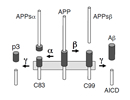Alpha-Secretase Cleavage of the Amyloid Precursor Protein: Proteolysis Regulated by Signaling Pathways and Protein Trafficking
Lichtenthaler SF.
23.05.2011
Proteolytic processing of APP by alpha, beta- and gamma-secretase. The type I membrane protein APP is proteolytically processed along two pathways. In the so called amyloidogenic pathway APP is sequentially cleaved by beta-secretase and then gamma-secretase. beta-secretase cleavage occurs within the ectodomain of APP close to the transmembrane domain, resulting in the secretion/shedding of the soluble APP ectodomain (APPs") and the formation of the membrane-bound C-terminal fragment C99 (C-terminal 99 amino acids of APP). gamma-secretase cleaves C99 giving rise to Abeta secretion and the formation of the APP intracellular domain (AICD). In the alternative, non-amyloidogenic pathway, APP is first cleaved by the metalloprotease alpha-secretase at a distance of 12 amino acids from the transmembrane domain. This cleavage yields the soluble APP ectodomain APPsalpha and a C-terminal fragment (C83), which is further processed by gamma-secretase, leading to the secreted p3-peptide.
ABSTRACT
α-secretase is the name for a metalloprotease activity, which is assumed to play a key role in the prevention of the molecular mechanisms underlying Alzheimer's disease (AD). Proteases similar to α- secretase are essential for a wide range of biological processes, such as cell adhesion and embryonic development. The molecular culprit in AD is the amyloid β peptide (Aβ), which derives from the amyloid precursor protein (APP) through sequential cleavage by the two proteases β and γ-secretase. In contrast, α-secretase, which is the metalloprotease ADAM10, cleaves APP within the Aβ domain, thus preventing Aβ generation. Additionally, it produces a secreted APP ectodomain with neurotrophic and neuroprotective properties. An increase in α-secretase cleavage is considered a therapeutic approach for AD, but the molecular mechanisms regulating α-secretase cleavage are only partly known. Protein kinase C and mitogen-activated protein kinase constitute central signaling hubs for the regulation of α-secretase cleavage. Additionally, recent studies increasingly demonstrate that the correct spatial and temporal localization of the two membrane proteins APP and α-secretase is essential for efficient α-secretase cleavage of APP. This review highlights the role of signaling pathways and protein trafficking in the control of APP α-secretase cleavage.




